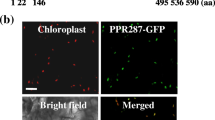Abstract
Pentatricopeptide repeat (PPR) proteins, containing tandem repeats of degenerate 35 amino acid motifs, are important for post-transcriptional chloroplast gene expression. In this study, we report the characterization of a pigment-deficient mutant 1 (pdm1) in Arabidopsis, which displays the albino phenotype. PDM1 contains 5 PPR motifs followed by a PLS domain. The levels of plastid-encoded polymerase-dependent chloroplast genes were reduced dramatically, whereas those of nucleus-encoded polymerase-dependent chloroplast genes increased in the mutant. In addition, the pattern of rpoA pre-mRNA was altered and the rpoA transcript was absent in pdm1. Thus, these results suggest that PDM1 is required for processing of rpoA pre-mRNA in Arabidopsis.
Similar content being viewed by others
References
Hajdukiewicz P T J, Allison L A, Maliga P. The two RNA polymerases encoded by the nuclear and the plastid compartments transcribe distinct groups of genes in tobacco plastids. EMBO J, 1997, 16: 4041–4048
Hedtke B, Börner T, Weihe A. Mitochondrial and chloroplast phage-type RNA polymerases in Arabidopsis. Science, 1997, 277: 809–811
Kapoor S, Suzuki J Y, Sugiura M. Identification and functional significance of a new class of non-consensus-type plastid promoters. Plant J, 1997, 11: 327–337
Liere K, Maliga P. In vitro characterization of the tobacco rpoB promoter reveals a core sequence motif conserved between phage-type plastid and plant mitochondrial promoters. EMBO J, 1999, 18: 249–257
Lurin C, Andres C, Aubourg S, et al. Genome-wide analysis of Arabidopsis pentatricopeptide repeat proteins reveals their essential role in organelle biogenesis. Plant Cell, 2004, 16: 2089–2103
Small I, Peeters N. The PPR motif-a TPR-related motif prevalent in plant organellar proteins. Trends Biochem Sci, 2000, 25: 45–47
Meierhoff K, Felder S, Nakamura T, et al. HCF152, an Arabidopsis RNA binding pentatricopeptide repeat protein involved in the processing of chloroplast psbB-psbT-psbH-petB-petD RNAs. Plant Cell, 2003, 15: 1480–1495
Hashimoto M, Endo T, Peltier G, et al. A nucleus-encoded factor, CRR2, is essential for the expression of chloroplast ndhB in Arabidopsis. Plant J, 2003, 36: 541–549
Schmitz-Linneweber C, Williams-Carrier R E, Williams-Voelker P M, et al. A pentatricopeptide repeat protein facilitates the trans-splicing of the maize chloroplast rps12 pre-mRNA. Plant Cell, 2006, 18: 2650–2663
Kotera E, Tasaka M, Shikana T. A pentatricopeptide repeat protein is essential for RNA editing in chloroplasts. Nature, 2005, 433: 326–330
Okuda K, Myouga F, Motohashi R, et al. Conserved domain structure of pentatricopeptide repeat proteins involved in chloroplast RNA editing. Proc Natl Acad Sci USA, 2007, 104: 8178–8183
Okuda K, Chateigner-Boutin A L, Nakamura T, et al. Pentatricopeptide repeat proteins with the DYW motif have distinct molecular functions in RNA editing and RNA cleavage in Arabidopsis chloroplasts. Plant Cell, 2009, 21: 146–156
Zhou W, Cheng Y, Yap A, et al. The Arabidopsis gene YS1 encoding a DYW protein is required for editing of rpoB transcripts and the rapid development of chloroplasts during early growth. Plant J, 2008, 58: 82–96
Chateigner-Boutin A L, Ramos-Vega M, Guevara-Garcĭøa A, et al. CLB19, a pentatricopeptide repeat protein required for editing of rpoA and clpP chloroplast transcripts. Plant J, 2008, 56: 590–602
Cai W H, Ji D L, Peng L W, et al. LPA66 is required for editing psbF chloroplast transcripts in Arabidopsis. Plant Physiol, 2009, 150: 1260–1271
Yu Q B, Jiang Y, Chong K, et al. AtECB2, a pentatricopeptide repeat protein, is required for chloroplast transcript accD RNA editing and early chloroplast biogenesis in Arabidopsis thaliana. Plant J, 2009, 59: 1011–1023
Yamazaki H, Tasaka M, Shikanai T. PPR motifs of the nucleus-encoded factor, PGR3, function in the selective and distinct steps of chloroplast gene expression in Arabidopsis. Plant J, 2004, 38: 152–163
Williams P M, Barkan A. A chloroplast-localized PPR protein required for plastid ribosome accumulation. Plant J, 2003, 36: 675–686
Chi W, Ma J F, Zhang D Y, et al. The PPR protein DG1 is involved in the regulation of early chloroplast development and chloroplast gene expression in Arabidopsis thaliana. Plant Physiol, 2008, 108: 573–584
Liu Y G, Mitsukawa N, Oosumi T, et al. Efficient isolation and mapping of Arabidopsis thaliana T-DNA insert junctions by thermal asymmetric interlaced PCR. Plant J, 1995, 8: 457–463
Peng L W, Ma J F, Chi W, et al. LOW PSII accumulation 1 is involved in efficient assembly of photosystem II in Arabidopsis thaliana. Plant Cell, 2006, 18: 955–969
Ma J F, Peng L W, Guo J K, et al. LPA2 is required for efficient assembly of photosystem II in Arabidopsis thaliana. Plant Cell, 2007, 19: 1980–1993
Krause K, Maier R M, Kofer W, et al. Disruption of plastid-encoded RNA polymerase genes in tobacco: Expression of only a distinct set of genes is not based on selective transcription of the plastid chromosome. Mol Gen Genet, 2000, 263: 1022–1030
Legen J, Kemp S, Krause K, et al. Comparative analysis of plastid transcription profiles of entire plastid chromosomes from tobacco attributed to wild-type and PEP-deficient transcription machineries. Plant J, 2000, 31: 171–188
Serino G, Maliga P. RNA polymerase subunits encoded by the plastid rpo genes are not shared with the nucleus-encoded plastid enzyme. Plant Physiol, 1998, 117: 1165–1170
Pfalz J, Liere K, Kandlbinder A, et al. pTAC2, -6, and -12 are components of the transcriptionally active plastid chromosome that are required for plastid gene expression. Plant Cell, 2006, 18: 176–197
Author information
Authors and Affiliations
Corresponding author
About this article
Cite this article
Wu, H., Zhang, L. The PPR protein PDM1 is involved in the processing of rpoA pre-mRNA in Arabidopsis thaliana . Chin. Sci. Bull. 55, 3485–3489 (2010). https://doi.org/10.1007/s11434-010-4040-4
Received:
Accepted:
Published:
Issue Date:
DOI: https://doi.org/10.1007/s11434-010-4040-4




